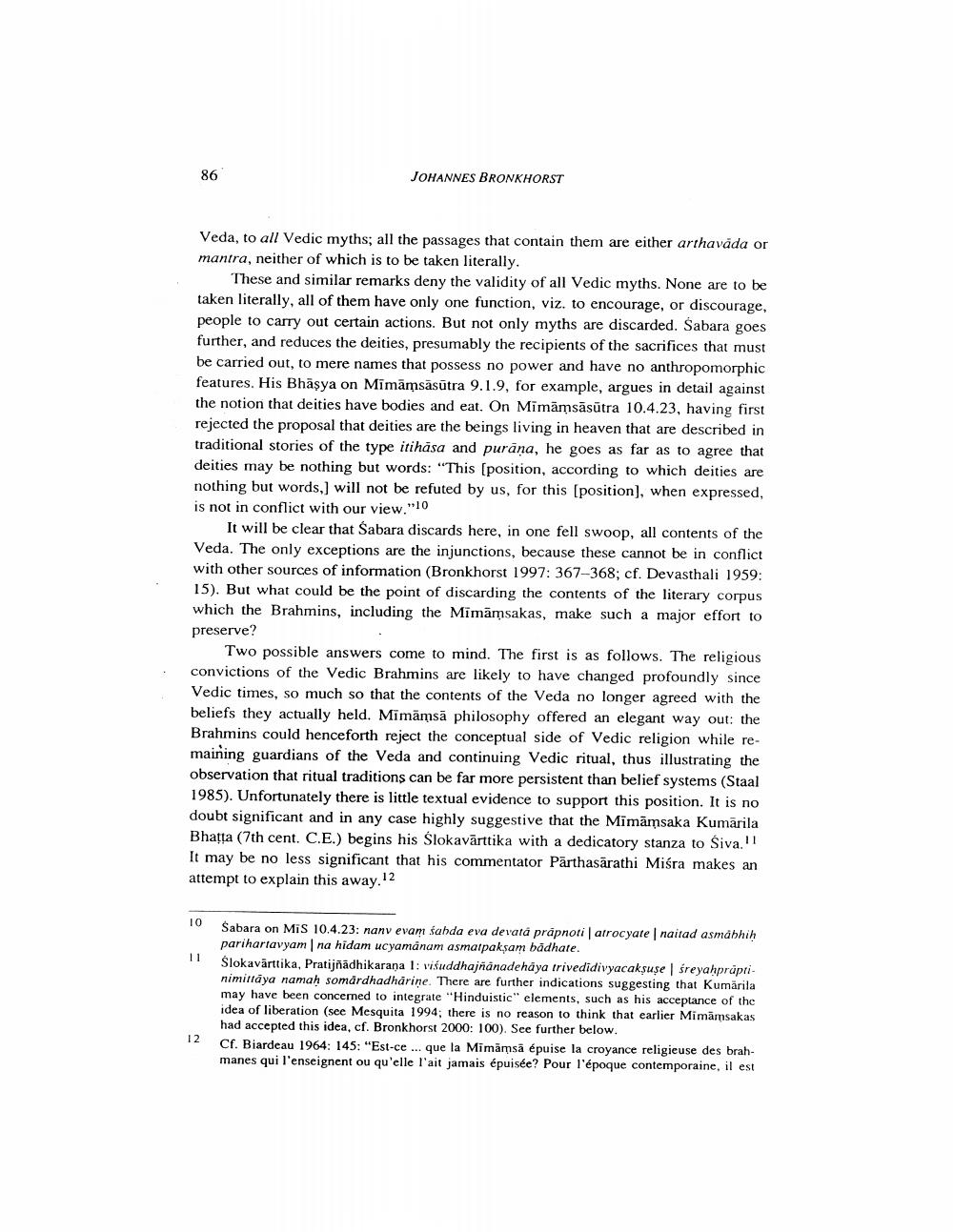Book Title: Origin Of Mimamsa As A School Of Thought A Hypothesis Author(s): Johannes Bronkhorst Publisher: Johannes Bronkhorst View full book textPage 4
________________ 86 JOHANNES BRONKHORST Veda, to all Vedic myths; all the passages that contain them are either arthavada or mantra, neither of which is to be taken literally. These and similar remarks deny the validity of all Vedic myths. None are to be taken literally, all of them have only one function, viz. to encourage, or discourage, people to carry out certain actions. But not only myths are discarded. Sabara goes further, and reduces the deities, presumably the recipients of the sacrifices that must be carried out, to mere names that possess no power and have no anthropomorphic features. His Bhāşya on Mimāmsāsūtra 9.1.9, for example, argues in detail against the notion that deities have bodies and eat. On Mimāmsāsūtra 10.4.23, having first rejected the proposal that deities are the beings living in heaven that are described in traditional stories of the type itihäsa and purāņa, he goes as far as to agree that deities may be nothing but words: "This (position, according to which deities are nothing but words) will not be refuted by us, for this position), when expressed, is not in conflict with our view."10 It will be clear that Sabara discards here, in one fell swoop, all contents of the Veda. The only exceptions are the injunctions, because these cannot be in conflict with other sources of information (Bronkhorst 1997: 367-368; cf. Devasthali 1959: 15). But what could be the point of discarding the contents of the literary corpus which the Brahmins, including the Mimāmsakas, make such a major effort to preserve? Two possible answers come to mind. The first is as follows. The religious convictions of the Vedic Brahmins are likely to have changed profoundly since Vedic times, so much so that the contents of the Veda no longer agreed with the beliefs they actually held. Mimämsä philosophy offered an elegant way out: the Brahmins could henceforth reject the conceptual side of Vedic religion while remaining guardians of the Veda and continuing Vedic ritual, thus illustrating the observation that ritual traditions can be far more persistent than belief systems (Staal 1985). Unfortunately there is little textual evidence to support this position. It is no doubt significant and in any case highly suggestive that the Mimāmsaka Kumārila Bhatta (7th cent. C.E.) begins his Slokavārttika with a dedicatory stanza to Siva.!! It may be no less significant that his commentator Pärthasarathi Miśra makes an attempt to explain this away. 12 10 Sabara on Mis 10.4.23: nany evam sabda eva devatá prápnoti atrocyate naitad asmábhih parihartavyam | na hidam ucyamanam asmatpaksam badhate. Slokavärttika, Pratijnadhikarana 1 : wisuddhajñanadehåya trivedidivyacaksuse sreyahpräprinimittaya namah somårdhadharine. There are further indications suggesting that Kumärila may have been concerned to integrate "Hinduistic elements, such as his acceptance of the idea of liberation (see Mesquita 1994, there is no reason to think that earlier Mimamsakas had accepted this idea, cf. Bronkhorst 2000: 100). See further below. Cf. Biardeau 1964: 145: "Est-ce ... que la Mimämsä épuise la croyance religieuse des brahmanes qui l'enseignent ou qu'elle l'ait jamais épuisée? Pour l'époque contemporaine, il est 12Page Navigation
1 2 3 4 5 6 7 8 9 10 11 12 13 14 15 16 17 18 19 20 21
